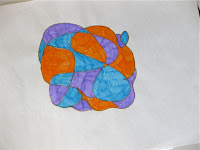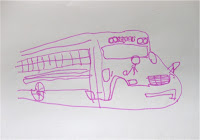Today's older class repeated what we did the younger class—we started with one of my favourite, fun warm-up exercise—The Scribble Challenge! This fun activity for all ages that is great for developing our problem solving ability. Have I ever mentioned how I even have had my parent's try this one?
Once again, here is what we did—we started by using a marker of any colour, and made a large scribble on paper. Next, we filled in the spaces of our scribbles while trying our best to follow these two rules:
- Use only three colours.
- The same colour cannot share a "wall".
Staying on the theme of outlines and fills as created by our scribble drawings, we then moved on to today's project—TRACING.
I'll say it again, tracing rocks! Tracing an image can help us create muscle memory, to practice new and intricate lines and forms that we might never have drawn freehand and to train ourselves to "draw what we see and not what we think we see". It It can also create the foundation for a drawing to allow us to focus more on details like shading and texture.
For today's lesson, I used the beautiful, large windows that we have at our location. For each student, I taped up a printed photo of their choice. Student were to choose from pictures of buses or flowers. Over each photo, I taped a clean white sheet of paper.
The interesting thing with this older group is that most chose the flowers with more curved lines and less small details. Some did try the buses later but those curves and organic flower shapes were just more appealing than those straight structured lines of the buses, today anyway.
After tracing, it was detail time! All colours of marker and pencils too were pulled out and the children were set free to decorate as they saw fit. Students applied all kinds of different textures and colour combinations. With these older kids, we also see some interesting attempts at shading and creating depth through colour variation (check out the use of the different greens in the pics below).


























































